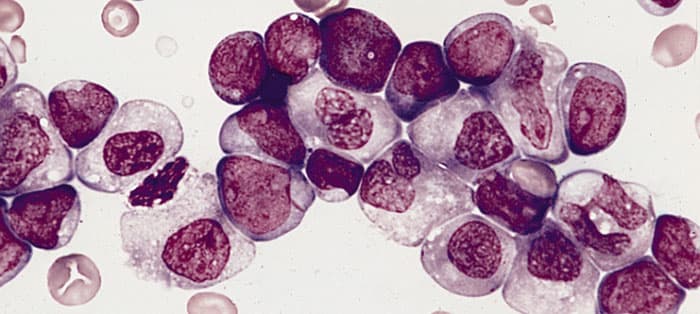Two genetic factors found to play essential role in leukemia

A gene previously thought to be a tumor suppressor, and a newly characterized microRNA, appear to have essential roles in causing a common form of leukemia, potentially pointing to new targets in the search for ways to combat a currently therapy-resistant type of the disease. A gene previously thought to be a tumor suppressor, and a newly characterized microRNA, appear to have essential roles in causing a common form of leukemia, report University of Chicago scientists in two separate studies published July in the Proceedings of the National Academy of Sciences.
Their findings point to new targets in the search for ways to combat a currently therapy-resistant type of the disease. Almost 15,000 Americans will be diagnosed this year with acute myeloid leukemia (AML), a bone marrow cancer characterized by uncontrolled growth of immature white blood cells. Abnormal rearrangements of the mixed-lineage leukemia (MLL) gene, which plays an important role in gene regulation, cause roughly 10 percent of adult and 80 percent of infant cases of AML.
To better understand the genetic mechanisms responsible for this particular leukemia, Jianjun Chen, PhD, an assistant professor of hematology and oncology at the University of Chicago Medicine, led two separate studies with help from frequent collaborator Janet Rowley, MD, the Blum-Riese distinguished service professor in the departments of medicine, molecular genetics and cell biology, and human genetics
The first one analyzed TET1, a gene previously shown to be a tumor suppressor in prostate and breast cancers. As TET1 was known to fuse with the MLL gene in a few cases of AML, Chen and his team looked to see if TET1 played a similar tumor-suppressing role in leukemia.
To their surprise, the gene instead appeared to play a crucial oncogeneic role in AML. Performing large-scale genetic expression profiles of 100 AML patients, Chen and his team found two- to eight-times higher levels of TET1 compared to controls. In addition, they showed that TET1 plays an important role in mediating a chain of genetic events activated by the MLL gene that ultimately leads to leukemia.
Of particular therapeutic interest, the team found that genetically modified mice lacking the TET1 gene showed greatly increased survival in a mouse model of leukemia. Eighty percent of mice without the gene survived until the end of the 150-day study, compared to 100 percent lethality in wild-type control animals after only 80 days.
"As an added benefit, the knockout of TET1 expression seems to have very minor effects on normal development," said Chen. "Given its essential function in MLL-rearranged leukemia, we think it is a promising target for potential therapeutic interventions." In their second study, Chen and his team looked at microRNA-9 (miR-9), a short strand of RNA that regulates the function of messenger RNAs. They found that miR-9 was the most specifically overexpressed microRNA in MLL-rearranged AML, and appeared to enhance the cancer.
Human leukemia cells in petri dishes exhibited stunted growth and decreased survivability when miR-9 was depleted. When expression of miR-9 was forced in these cells, they showed increased viability and enhanced immortalization, a primary characteristic of cancer. In addition, forced expression of miR-9 seemed to increase the likelihood that normal bone marrow cells would transform into cancerous cells.
"Though it is not sufficient to cause the leukemia on its own, our data suggest that miR-9 is a critical regulatory molecule in this disease," said Chen.
Chen and his team plan on studying the therapeutic possibilities of controlling both TET1 and miR-9 expression. As both are part of a chain of genetic responses caused by the MLL gene, Chen believes the need for a multi-targeted approach to treating leukemia seems likely.
"Comprehensive understanding of the roles of TET1 and miR-9 reveals more of the complex molecular mechanisms that cause MLL-mediated leukemia. We hope this will spur the development of effective strategies to treat this presently therapy-resistant disease," said Chen.
1. This work was supported by the National Institutes of Health, the Intramural Program of the National Human Genome Research Institute, the American Cancer Society, the Emory Genetics Discovery Fund, the G. Harold and Leila Y. Mathers Charitable Foundation, Gabrielle's Angel Foundation, the Leukemia and Lymphoma Society, and the University of Chicago Committee on Cancer Biology Fellowship Program.
2. This work was supported by the National Institutes of Health, the Intramural Program of National Human Genome Research, the American Cancer Society, the Leukemia and Lymphoma Society, the University of Chicago Committee on Cancer Biology fellowship program, and Gabrielle's Angel Foundation for Cancer Research.
=====
Huang H., Jiang X., Li Z., Li Y., Song C.X., He C., Sun M., Chen P., Gurbuxani S. & Wang J. & (2013). TET1 plays an essential oncogenic role in MLL-rearranged leukemia, Proceedings of the National Academy of Sciences, 110 (29) 11994-11999. DOI: 10.1073/pnas.1310656110
Chen P., Price C., Li Z., Li Y., Cao D., Wiley A., He C., Gurbuxani S., Kunjamma R.B. & Huang H. & (2013). miR-9 is an essential oncogenic microRNA specifically overexpressed in mixed lineage leukemia-rearranged leukemia, Proceedings of the National Academy of Sciences, 110 (28) 11511-11516. DOI: 10.1073/pnas.1310144110
